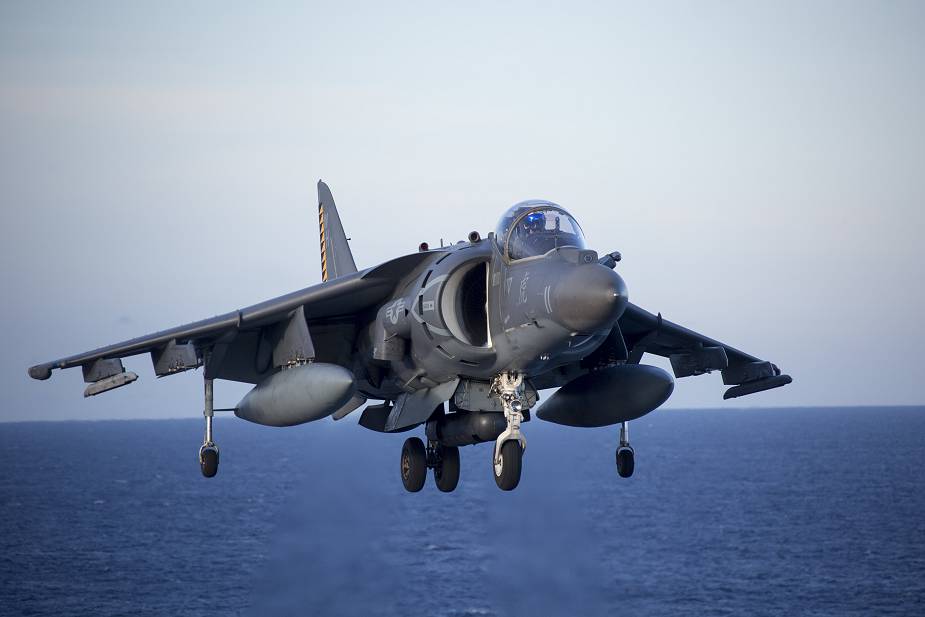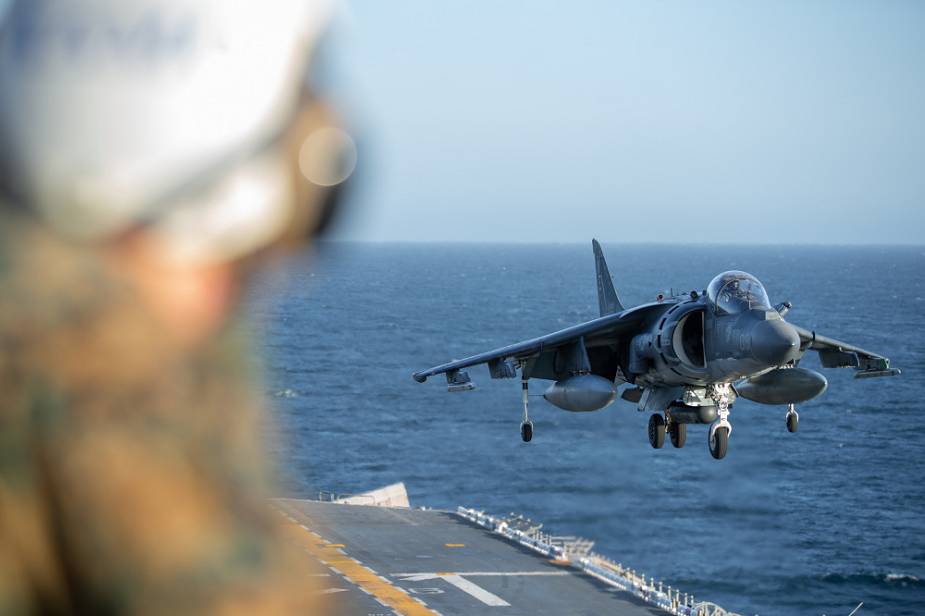AV-8B Harrier II attack aircraft will stay operational with US Marine Corps until 2029
The AV-8B Harrier II vertical or short takeoff and landing (V/STOL) attack aircraft will continue to be used by the U.S. Marine Corps until 2029 despite the arrival of the F-35B. U.S. Marine Corps AV-8B squadrons function as an integral unit or as a squadron with a deployed six aircraft detachment. This concept facilitates dual-site operations, provides for the support of simultaneous contingencies, and allows for the fulfillment of continuous unit deployment program requirements.
Follow Navy Recognition on Google News at this link
 U.S. Marine Corps AV-8B Harriers with Marine Medium Tiltrotor Squadron 365, 26th Marine Expeditionary Unit, conduct deck landing qualification aboard the amphibious assault ship USS Bataan during Amphibious Ready Group, MEU exercise in the vicinity of Camp Lejeune, North Carolina, Aug. 23, 2019. (Picture source U.S. Marines)
U.S. Marine Corps AV-8B Harriers with Marine Medium Tiltrotor Squadron 365, 26th Marine Expeditionary Unit, conduct deck landing qualification aboard the amphibious assault ship USS Bataan during Amphibious Ready Group, MEU exercise in the vicinity of Camp Lejeune, North Carolina, Aug. 23, 2019. (Picture source U.S. Marines)
In January 2021, U.S. Department of the Navy awarded Vertex Aerospace LLC the $123 million Contracted Maintenance, Modification, Aircrew, and Related Services (CMMARS) task order in July 2020 to provide aircraft maintenance and Contractor Logistics Support (CLS) services for the U.S. Marine Corps’ AV-8B Harrier fleet until 2029. Together, BAE Systems and Vertex Aerospace will support the crucial training and combat operations conducted from U.S. Navy’s aircraft carriers, amphibious assault ships, and forward operating bases.
The AV-8B Harrier II is a single-engine ground-attack aircraft that is the second generation of the Harrier Jump Jet family, capable of vertical or short takeoff and landing (V/STOL). The AV-8B is used by the United States Marine Corps (USMC), the Spanish Navy, the Italian Navy, and the United Kingdom. The mission of the U.S. marine AV-8B Harrier II VMA STOVL squadron is to attack and destroy surface and air targets, to escort helicopters, and to conduct other such air operations as may be directed.
The AV-8B Harrier II can be operated from small aircraft carriers, large amphibious assault ships and simple forward operating bases. It has participated in numerous military and humanitarian operations.
The AV-8B is equipped with one centerline fuselage and six wing hardpoints, along with two fuselage stations for a 25 mm GAU-12 cannon and ammunition pack. These hardpoints give it the ability to carry a total of 4,200 kg of weapons, including air-to-air, air-to-surface, and anti-ship missiles, as well as unguided and guided bombs.
The USMC maintains five active operational squadrons comprised of 16 AV-8B aircraft each and an FRS comprised of AV-8B and TAV-8B aircraft. It will maintain five operational squadrons until 2022. Marine Attack Squadron (VMA) of the West Coast will complete the transition to F-35 in 2023 while the East Coast will maintain the AV-8B Harrier II until 2028.
The current AV-8B active inventory consists of 124 aircraft. There are 16 TAV-8B training aircraft, 34 night attack aircraft, and 74 radar aircraft. The AV-8B fleet is currently fulfilling, with five squadrons, the operational commitments previously filled by seven squadrons.

An U.S. Marine AV-8B Harrier lands on the flight deck of Wasp-class amphibious assault ship USS Essex (LHD 2) during routine flight operations.
According to the 2019 U.S. Marine Aviation Plan, the evolution of AV-8B Harrier II over the next years will focus on avionics and software upgrades (LINK-16, RNP/RNAV, Mode 5/S, ADS-B out, Helmet Mounted Cueing System, upgraded survivability equipment).
The modernization plan of U.S. Marine AV-8B Harrier II also includes the capabilities to carry AIM-9X Sidewinder Block II short-range air-to-air missile and AIM-120C Advanced Medium-Range Air-to-Air Missile as well as the integration of LITENING Advanced Tactical Data Link (ATDL) to expand the capabilities of the current Gen 4 LITENING Pod by adding Band Efficient Common Data Link (BECDL), TTNT, and encryption to the current pod inventory.
The LITENING is an electro-optical infrared sensor system for targeting and surveillance that enables aircrews to detect, acquire, identify and track targets at long ranges. LITENING enables a wide range of missions, including precision targeting, close air support, intelligence, surveillance and reconnaissance, and humanitarian assistance.
In March 2021, AV-8B Harrier with Marine Attack Squadron (VMA) 214, 11th Marine Expeditionary Unit, has conducted flight operations from the Wasp-class amphibious assault ship USS Essex (LHD 2).
The Wasp is a class of landing helicopter dock (LHD) amphibious assault ships in service with the United States Navy. Currently, eight ships of this class are deployed by the U.S. Navy. The ship is capable of transporting almost the full strength of a United States Marine Corps Marine Expeditionary Unit (MEU), and landing them in the hostile territory via landing craft or helicopters as well as providing air support via AV-8B Harrier II attack aircraft or F-35B Lightning II stealth strike-fighters.


























